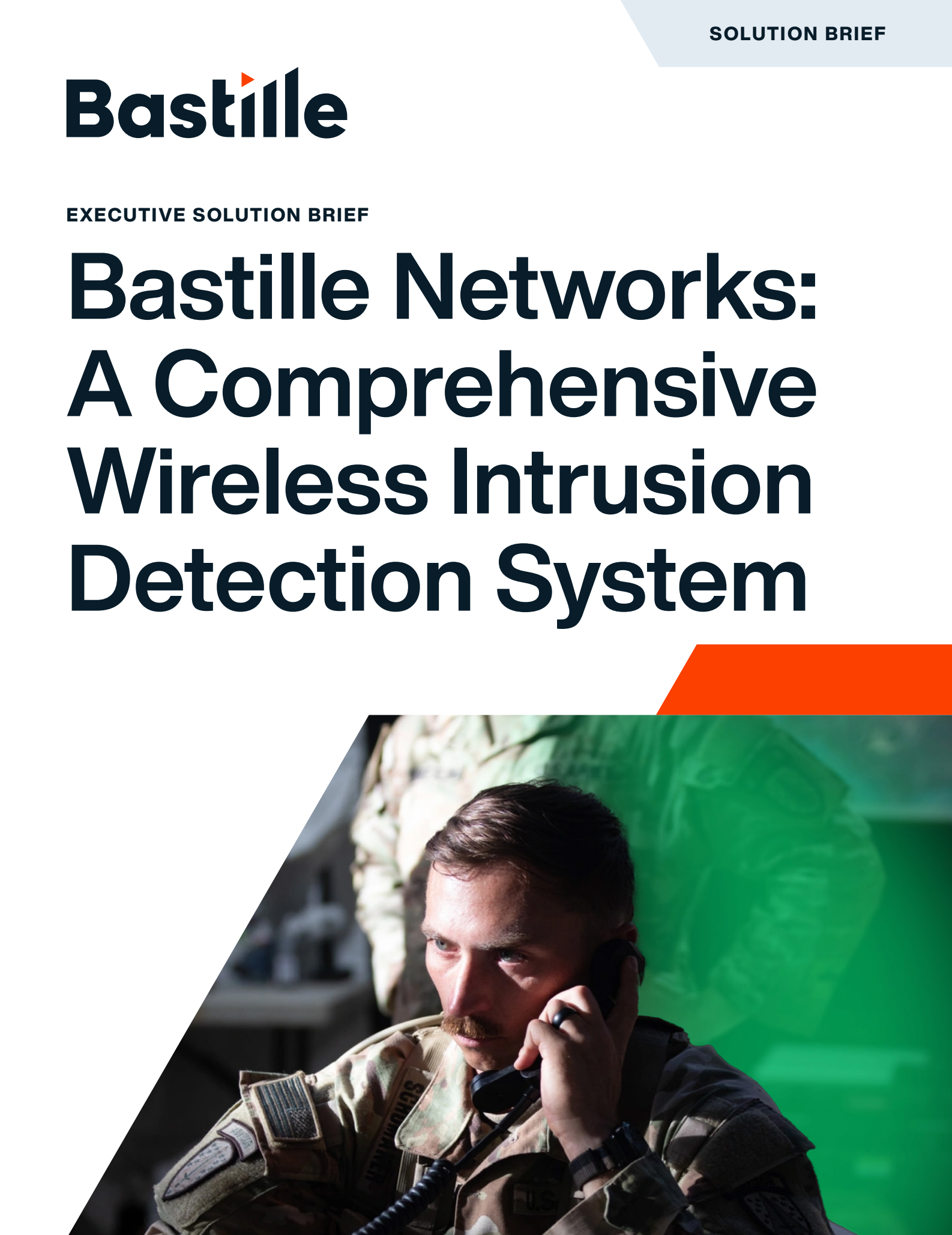
Table of Contents
Introduction: The Changing Face of Cybersecurity
Cybersecurity is undergoing a dramatic transformation. Threats no longer confine themselves to traditional wired networks or digital endpoints. As environments evolve and the number of wireless devices explodes, organizations, especially federal agencies, must recognize a new threat vector: the airspace.
Next-generation security stacks adopt Wireless Intrusion Detection Systems (WIDS) as a foundational layer to keep pace. These systems offer real-time monitoring of radio frequency (RF) activity, identifying rogue devices, RF anomalies, and unauthorized transmissions before they become data breaches.
This post explores why WIDS is essential to the future of cybersecurity and how it directly supports federal facilities, SCIFs, and agencies tasked with defending our most sensitive information.
Why Airspace Is the New Frontier in Threat Detection
The digital attack surface is no longer limited to software vulnerabilities or network ports. Today’s adversaries exploit wireless signals, including Wi-Fi, Bluetooth, Zigbee, and cellular. These signals are often unmonitored within secure facilities, leaving critical environments open to invisible threats.
Traditional tools, like firewalls and endpoint detection systems, don’t monitor the airspace. This area is where WIDS comes in. It fills the visibility gap, detecting:
- Unauthorized personal devices (phones, laptops, wearables)
- Rogue access points or evil twin Wi-Fi networks
- Bluetooth sniffers and wireless keystroke loggers
- RF jammers and data exfiltration attempts via radio
Airspace is the new attack vector. WIDS is the only tool designed to secure it.
The Rise of Wireless-Enabled Threats in Secure Facilities
Classified environments like SCIFs, data centers, and DoD installations are high-value targets. Modern threats can bypass perimeter defenses using wireless tactics even in tightly controlled spaces.
Examples include:
- A smartwatch left in a restricted area transmitting beacon packets
- A rogue sensor in an HVAC system emitting location data
- A malicious access point mimicking a secure network outside the facility
These devices can broadcast data or open up channels for command and control. Without WIDS, security teams are blind to these RF threats.
From Reactive to Proactive: WIDS as a Preventative Measure
Many security tools are reactive, detecting incidents after damage has occurred. WIDS offers a proactive approach by identifying and alerting for wireless anomalies before breaches happen.
With WIDS in place, federal agencies can:
- Define and enforce RF policy zones
- Receive alerts on real-time RF breaches
- Track wireless devices based on behavior and signal pattern
- Prevent wireless exfiltration of sensitive data
This shift from reaction to real-time prevention is key in high-security environments where every second counts.
Integrating WIDS into the Federal Cybersecurity Ecosystem
WIDS is not a replacement; it complements existing tools within the federal cybersecurity stack and adds a much-needed layer of wireless visibility.
It integrates with:
- SIEM platforms to provide RF event data alongside network logs
- SOAR systems to automate response based on device location or threat type
- Physical access systems to correlate RF events with user entry
- Compliance tools to generate audit-ready RF security reports
This integration ensures that WIDS strengthens overall situational awareness without creating operational friction.
Future-Proofing SCIFs and Secure Installations with WIDS
Secure Compartmented Information Facilities (SCIFs) are designed to eliminate RF leakage. But shielding isn’t perfect. Human error, equipment faults, or intentional sabotage can lead to unintended emissions or breaches.
WIDS empowers SCIF managers to:
- Monitor the integrity of RF shielding in real time
- Detect unauthorized signal emissions
- Identify devices that were not logged or declared
- Prove compliance with CNSSI 1253 and other security policies
By deploying zone-based WIDS, federal agencies can move beyond passive policy enforcement and adopt active RF threat detection.
Artificial Intelligence and Machine Learning in WIDS
As threats evolve, so must detection. WIDS solutions increasingly rely on AI and machine learning to detect subtle anomalies and anticipate risks.
AI-powered WIDS can:
- Learn what regular RF activity looks like for each zone
- Detect behavioral outliers from otherwise “approved” devices
- Reduce false positives by understanding the context
- Predict new threat patterns based on historical data
This intelligent detection turns WIDS into a predictive tool, not just a passive alarm system.
WIDS in the Age of Zero Trust Architecture
The Zero Trust model assumes that nothing inside or outside the network has trust by default. WIDS supports this philosophy by extending its validation to the airspace.
It helps enforce Zero Trust by:
- Constantly validating the legitimacy of RF signals
- Ensuring wireless transmissions are policy-compliant
- Detecting anomalies even from devices that appear to be authorized
- Correlating wireless activity with user behavior
In short, Zero Trust must include Zero RF Trust, and WIDS delivers it.
National Security Implications and WIDS Deployment
Wireless attacks don’t just threaten data; they threaten national security.
For federal agencies, the risks include:
- Classified information leaking via RF channels
- Adversarial surveillance using proximity-based devices
- Supply chain hardware compromised with embedded RF emitters
- Mobile RF jammers interrupting real-time mission execution
WIDS doesn’t just protect devices. It protects sovereignty, strategy, and lives.
The Role of WIDS in Cyber Resilience Strategy
Cyber resilience isn’t just about stopping attacks. It’s about recovering quickly, learning from them, and building adaptive defenses.
WIDS supports resilience by:
- Reducing time to detect RF-related incidents
- Enabling faster, more accurate incident response
- Providing forensic records for threat attribution
- Helping teams fine-tune policies based on real-world activity
In an era of relentless threats, resilience depends on full-spectrum visibility, including the wireless layer.
Case Insight: Preparing for the Future of Airspace Security at a National Intelligence Facility
A U.S. intelligence organization recognized the growing risks of unauthorized wireless transmissions, especially from personal devices and embedded IoT sensors.
To modernize its security posture and prepare for Zero Trust implementation, the agency selected Bastille’s Wireless Intrusion Detection System (WIDS) to monitor airspace across multiple SCIFs.
Shortly after deployment, Bastille identified an unclassified desktop printer in an adjacent office that periodically broadcasted over Zigbee, a protocol undeclared during facility provisioning. Though the signal was weak, it represented a potential cross-domain communication risk.
Bastille’s platform provided zone-based alerting, device fingerprinting, and a complete forensic timeline of the printer’s transmissions. The IT and security teams were able to isolate and replace the device before any data leakage could occur.
This proactive detection aligned with the agency’s cyber resilience strategy and demonstrated the power of full-spectrum airspace visibility as a key pillar in future-ready security architecture.
Challenges Ahead: RF Complexity and Device Proliferation
The RF spectrum is getting noisier. As more smart devices enter secure environments, distinguishing between legitimate and rogue signals will be harder.
Challenges include:
- Device sprawl, especially in supply chain and logistics
- Advanced signal-masking techniques by attackers
- Inadvertent RF emissions from consumer electronics
- Growing reliance on wireless communication in secure zones
The future of WIDS lies in handling this complexity without overwhelming security teams.
The Evolution of Wireless Threat Intelligence
WIDS is evolving from a detection tool to a wireless threat intelligence hub.
Key developments include:
- Threat-sharing frameworks between agencies
- Centralized RF threat databases
- Predictive analytics based on cross-location data
- Forensic-grade timelines of wireless activity
WIDS will continue to evolve into a strategic intelligence asset, supporting broader cyber operations.
Conclusion: Building a Future-Ready Security Stack
The future of cybersecurity belongs to those who see what others ignore. In a world of firewalls and endpoint scanners, WIDS offers a rare kind of visibility: the ability to detect what’s happening in the wireless environment in and around a facility.
Federal agencies can no longer afford to treat wireless as an afterthought. From Zero Trust to national defense, the future of security requires complete airspace awareness.
Explore how Bastille’s Wireless Intrusion Detection System brings this capability to the front lines of defense.
FAQS About the Future of WIDS
What is WIDS, and how is it different from traditional network security?
WIDS (Wireless Intrusion Detection System) monitors the wireless spectrum, such as Wi-Fi, Bluetooth, and Zigbee, rather than traditional wired networks. While firewalls and endpoint detection protect against digital threats on the network, WIDS identifies unauthorized wireless activity, like rogue access points or RF jammers, that operate outside standard network visibility.
Why is wireless airspace becoming a top priority for cybersecurity teams?
Thanks to the explosion of wireless-enabled devices and the growing use of IoT, the airspace within and around secure facilities is now a significant attack surface. Threat actors can exploit RF signals to bypass traditional defenses. As agencies shift to Zero Trust and proactive defense, securing the airspace becomes essential to reducing risk and maintaining control.
Can WIDS help federal agencies meet compliance requirements?
Yes. WIDS supports compliance with frameworks like NIST SP 800-53, CNSSI 1253, and RMF, especially regarding monitoring, anomaly detection, and RF zoning in SCIFs and high-security areas. It enables agencies to document and enforce RF policy while preparing for audits and Authority to Operate (ATO) processes.
Is WIDS effective in SCIFs and restricted federal environments?
Absolutely. WIDS is ideal for SCIFs because it operates passively, without transmitting signals or requiring network access. It detects signal leakage, unauthorized devices, and shielding failure—helping ensure operational integrity in highly controlled zones.
How will AI shape the future of Wireless Intrusion Detection?
Artificial Intelligence is revolutionizing WIDS by allowing it to learn from historical RF patterns, recognize subtle anomalies, and reduce false alerts. AI enables more precise detection, adaptive alerting, and predictive threat intelligence, making WIDS reactive and strategically proactive in future cybersecurity defense.


